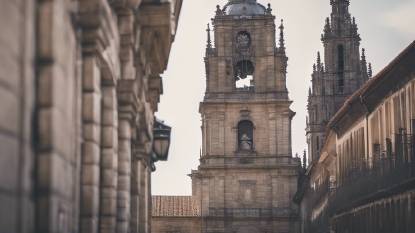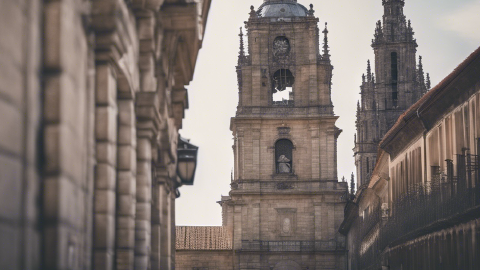
Santiago de Compostela Cathedral: Travel Facts
Posted: | Updated:
Reading time: 31 minutes
Santiago de Compostela Cathedral: Travel Facts
Posted: | Updated:
Reading time: 31 minutes
By: Simon Kemp, Editor
Your Pilgrim and Visitor Guide
The Cathedral of Santiago de Compostela, located at the end point of the famed Camino de Santiago pilgrimage route in Galicia , Spain, reigns as one of the most glorious and symbolic holy sites in all of Christendom.
Is the cathedral worth a visit? Yes, of course it is. As the most majestic building in all of Galicia, this monument to faith and artistic endeavour stands as one of the great European cathedrals.
Known colloquially as the “Santiago Cathedral” and consecrated in the 11th century, this magnificent Romanesque edifice has stood as the vibrant spiritual beacon for the hundreds of thousands that complete the Camino pilgrimage trails each year.
The Cathedral’s resplendent spires and ornate Portico de la Gloria doorway hearken to a faith unbroken by the centuries of worship, fire and reconstruction that echo within these stone walls.
Beyond the external Baroque finery added through later eras, inside the Cathedral lays the ornate Crypt housing the glittering tomb and remains of St. James. This apostle of Christ and patron saint of Spain makes the cathedral one of the most important Christian shrines, drawing over 350,000 religious pilgrims annually.
These devoted followers flock towards the rear of the Cathedral to touch the pillar marking the final steps for pilgrims entering after their long spiritual journeys.
For over a millennia, emperors, popes, and paupers alike have trekked here on their own pilgrimages, forging an unmatched and ongoing legacy for this hallowed Cathedral at the very end of the Way of St. James.
Key Takeaways
Here’s a comprehensive overview of the Santiago de Compostela Cathedral incorporating detailed aspects about its construction, architecture, and history:
- Construction Timeline: Initiated in 1075 under King Alfonso VI and Bishop Diego Peláez, the cathedral’s main structure was consecrated in 1211.
- Architects and Design: The Romanesque design was primarily crafted by Bernard the Elder, with contributions from Robertus Galperinus and possibly later by Esteban. Bernard the Younger and Galperinus continued the work through its later stages.
- Bells and Clock Tower: Known as “Berenguela” or “Trinidad”, the Clock Tower houses a clock and two bells, not the originals, with the initial bell dating from 1738 now placed in the cloister.
- Architectural Styles: Initially Romanesque, the cathedral has significant Gothic and Baroque additions, including a Baroque facade completed by Fernando de Casas Novoa in 1740.
- Facility Dimensions: The cathedral stretches 97 meters long, designed to accommodate the numerous pilgrims who visit, with the nave reaching a height of 22 meters.
- Key Facades: The Platerías facade, built by Master Mateo, is the oldest remaining Romanesque facade and features reliefs depicting scenes from Christ’s life.
- Interior Features: The Portico de la Gloria, completed by Master Mateo in the 12th century, is a notable Romanesque portico with apocalypse-inspired iconography.
- Pilgrimage Significance: Serving as the traditional endpoint of the Camino de Santiago, the cathedral has been a major pilgrimage site since the Early Middle Ages.
- Accessibility and Visiting Information: The cathedral is accessible to visitors with disabilities, offers audio guides in multiple languages, and has multiple parking options nearby.
- Recent Restoration: Continuous restoration efforts, including the latest completed on the Obradoiro facade in 2020, help preserve its structural and aesthetic integrity.
Practical Information for Visitors
The Cathedral is a monumental masterpiece that marks the culmination of the famous Camino de Santiago pilgrimage. Below, you’ll find a detailed guide to help you plan your visit, covering visiting hours, ticketing information, transportation options, and nearby accommodations.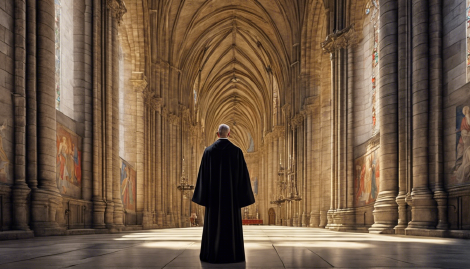
Location
The Cathedral of Santiago de Compostela is located in Obradoiro Square, Santiago de Compostela, A Coruna, 15704. Spain
Visiting Hours
- Basilica (Pilgrim’s Mass): Open daily from 7 am to 9 pm. Entrance through Porta de Praterías.
- Sepulchre and Embrace of Saint James the Apostle: Accessible every day from 8:30 am to 9 pm via Porta de Acibechería.
- Museum: The permanent collection, Gelmírez Palace, roofs, and Portico of Glory are open Monday to Sunday, from 10 am to 8 pm.
- Archive Library:Available for researchers from Monday to Friday, 9:30 am to 1 pm.
- Pilgrim’s Reception Office: Open from 9 am to 7 pm.
Some more detail in the table below with approximate costs:
| Facility | Location | Opening Times | Additional Information |
|---|---|---|---|
| Cathedral Main Access | Porta de Praterías | Daily: 7 am - 9 pm | Open for worship and prayer. |
| Sepulchre and Embrace | Inside the Cathedral | Daily: 8:30 am - 9 pm | Access through Porta de Acibechería. |
| Museum of the Cathedral | Cathedral Complex | Monday - Sunday: 10 am - 8 pm | Tickets: €12 adults, €10 students/seniors, free for children under 12. |
| Archive and Library | Cathedral Complex | Monday - Friday: 9:30 am - 1 pm | Access for researchers by appointment only. |
| Pilgrim’s Reception Office | rúa Carretas, 33 | Daily: 9 am - 7 pm | Issue of pilgrim’s certificate/compostela for qualifying pilgrims. |
Ticket Information
Ticket holders can explore various parts of the Cathedral, including the Permanent collection, Cloister, Treasure and Relics’ Chapel, Xelmírez Palace, Portico of the Glory, the roof and Ratchet Tower, and the Church of Santa María de Sar. For up-to-date ticket prices and to book your visit, check the Cathedral’s official website.
Accessibility
The Cathedral is accessible for visitors with special needs. Here are some details:
The Cathedral is wheelchair accessible through the back and there are tours available that are specifically designed to be wheelchair accessible. These tours often involve some walking/rolling and use of an adapted vehicle for transportation.
The tours typically include the Cathedral, Abastos Market, Quintana Square, Obradoiro Square, Museum of the Galician People, Gelmirez Palace, Cabildo’s House, São Domingos Convent, The Monastery Colegiada de Santa Maria do Sar, Capela Ánimas, and Alameda Park.
Please note that it’s always a good idea to check with the tour operator or the Cathedral directly to ensure how they can accommodate specific needs
Audio Guides
Audio guides are available in Spanish, French, English, and Gallego, enriching your visit with detailed narratives of the Cathedral’s history and architecture
Best Time of Year to Visit
This Romanesque jewel is open year-round to visitors. However, the best time to visit is Easter for its rich Holy Week processions and ceremonies like the famous Pilgrim’s Mass. The Holy Year, when the Feast of St. James falls on a Sunday (next in 2027), offers plenary indulgence - a special occasion.
Other major religious festivals like Christmas, Corpus Christi, and the Feasts of St. James in July provide vibrant celebrations to experience.
The famous Botafumeiro incense lantern is operated during the most important religious solemnities and there is a Botafumeiro calendar below.
Map, Transportation & Parking
Transportation
As one of the most important pilgrimage destinations in the world and the final stop of the Camino de Santiago, a network of ancient routes that lead to the tomb of Saint James the Apostle. If you are planning to visit this magnificent site, you may wonder how to get there from different transportation options. Fortunately, this city is highly connected. Here are some tips to help you out.
- By Car: Santiago is well-connected by the A-6 and A-52 motorways, parking details for several nearby parking garages are below.
- By Bus: The Santiago de Compostela Bus Station offers hourly services to major Galician towns. The nearest bus stop to the cathedral is for the Number 5 bus.
- By Train: Santiago de Compostela Railway Station has connections to major Spanish cities. From the station, take the Number 6 bus.
- By Plane: Santiago Airport is just 10 kilometers from the city.
- By Bike: Bike hire companies like Tornride offer services in the city
Here is more detailed information presented in a table with approximate costs for each mode of transportation.
| Mode of Transport | Starting Point | Options Description | Duration | Cost Estimate |
|---|---|---|---|---|
| Plane | Santiago de Compostela Airport (SCQ) | Bus: Line 6A to San Caetano (10-min walk to cathedral), every 30 mins, €1.50/person. Bus: Line EI to city center (near cathedral), hourly, €3/person. Taxi: Direct, ~15 mins, €50-€65. Car: Drive, ~15 mins, €2-€4. Towncar: Luxury service, ~15 mins, €172. | 10-15 mins | €1.50 - €172 |
| Train | Santiago de Compostela Railway Station | Bus: Line C2 to Plaza de Galicia (5-min walk to cathedral), every 15 mins, €1/person. Taxi: Direct, ~10 mins, ~€6. Foot: Walk, ~20 mins, free. | 10-20 mins | €1 - €6 |
| Bus | Bus Station Space | Bus: Any bus to Plaza de Galicia or Rúa do Hórreo (5-min walk to cathedral), frequent services, €1/person. Taxi: Direct, ~5 mins, ~€4. Foot: Walk, ~15 mins, free. | 5-15 mins | €1 - €4 |
Parking nearby to the cathedral
If you’re planning to visit by car, finding parking near the Cathedral can be challenging due to the area’s popularity with tourists. Here are some options for parking near the Cathedral:
- San Clemente Parking: Located approximately 5 minutes on foot from the Cathedral. The address is Avenida de Rodrigo de Padrón.
- Saba Parking: Av. de Lugo, 15702 Santiago de Compostela, A Coruña.
- Parclick: Parclick does not have a specific address as it is an online platform that provides information about various parking spaces. However, they do offer parking services in Santiago de Compostela.
- Rosalia Parking: Avenida de Rosalía de Castro, 46, 15701 Santiago de Compostela
To avoid the hassle of finding a parking spot upon arrival, it’s recommended to reserve a parking space in advance. You can use platforms like Parkimeter or Parclick to search, compare, and choose the most convenient public parking depending on your situation.
Cathedral Origins & History
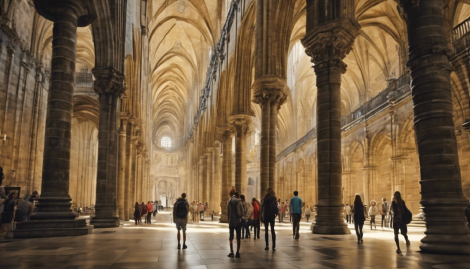
According to tradition, in 813 AD a hermit named Pelagius discovered the lost tomb of the apostle James in a Romanesque cemetery that once held the remains of Saint Saturninus. The news of apostolic remains discovery confirmed Compostela as a site of holy importance.
The Asturian king Alfonso II oversaw the building of a small stone church in 829 AD to house the sacred relics, marking the beginnings of the Cathedral of Santiago.
Over the next decades Compostela became a place of burgeoning pilgrimage. This lead to King Alfonso III commencing construction on a grand basilica in 899 AD to accommodate the influx of devotees to St. James’s remains.
The Medieval Cathedral
Seeking to develop Compostela into a powerful European capital, King Alfonso VI of León and Castile began sponsoring the construction of an ornate Romanesque cathedral in 1075 under the supervision of Bishop Diego Peláez.
Work slowly progressed for over a century until Master Mateo took over construction oversight in 1168. The famous stone mason introduced intricately carved Romanesque architectural innovation visible in the cathedral’s Pórtico de la Gloria entranceway.
Multiple damaging fires during the 12th-14th centuries led to ongoing reconstruction efforts, like that following the 1423 fire which heavily damaged the original nave.
The Baroque Transformation
After suffering deterioration, in the mid-1600s Bishop Miguel Garcia de Espinosa made the decision to completely overhaul the crumbling medieval cathedral in the popular Spanish Baroque architectural style. Between 1671-1703, esteemed architect Domingo de Andrade led the comprehensive project involving demolishing sections and dramatically expanding the structure to include a resplendent dome, soaring twin bell towers and grand symmetrical stone façade at the Obradoiro entrance exiting onto the Plaza del Obradoiro square.
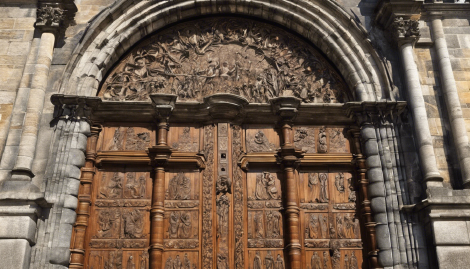
Further Expansions & Renovations
Construction and ornamentation continued through the 1700s like the addition of the Chapel of Relics in 1748 housing lavish Baroque tombs of medieval kings. Further fires in 1758 and again in 1965 spurred additional renovations including Crypt improvements in the late 18th century allowing pilgrims to traverse down low and venerate relics like St James’s flower-adorned silver casket.
Current Era Preservation Efforts
Despite weathering impactful historical fires, storms and earthquakes for over a millennia, like the damage sustained to the Pórtico de la Gloria entrance during the 2013 earthquake.
The Cathedral of Santiago continues standing proud as an preserved Catholic sanctuary that remains integral to the enduring Santiago de Compostela pilgrimage tradition. Over 3 million religious adherents and sightseers pass through the historic holy site from over 100 countries across the planet each year.
Notable figures, architects, and artisans like Mateo, Andrade helped evolve this grand Cathedral over 10 centuries of change while retaining its enduring devotional spirit for the hundreds of thousands journeying to venerate St. James’s remains through the ages.
Significant Figures in the History of the Cathedral
- St. James the Apostle (Santiago)
- Role: Central figure of the cathedral; he is believed to be buried at the site.
- Impact: The discovery of his tomb transformed the location into a significant pilgrimage destination for Christians.
- King Alfonso II of Asturias (759-842)
- Initiative: Initiated the construction of the original church on St. James’s tomb.
- Legacy: Laid the groundwork for the cathedral as a major pilgrimage site.
- Bishop Diego Peláez (11th century)
- Construction: Began the Romanesque structure of the cathedral in 1075.
- Contribution: Transformed a modest shrine into a grand architectural structure.
- Architect Maestro Mateo (12th century)
- Design and Construction: Worked on the Portico de la Gloria, a Romanesque masterpiece.
- Artistic Influence: His work is celebrated for its artistic and architectural innovation.
- Pope Alexander III (c. 1100–1181)
- Declaration: Recognized the Shrine of St. James as a holy city, on par with Jerusalem and Rome.
- Impact: Increased the cathedral’s importance and the number of pilgrims.
- Ferdinand II of León (1137–1188) and Alfonso VIII of Castile (1155–1214)
- Royal Patronage: Provided funds and support for the cathedral’s construction and embellishment.
- Cultural and Religious Significance: Enhanced the cathedral’s status and grandeur.
- Francis of Assisi (1181/1182 – 1226)
- Pilgrimage: Believed to have made a pilgrimage to the cathedral.
- Legacy: Highlights the cathedral’s influence across different Christian denominations.
- Modern-day Popes
- Visits and Recognition: Popes, including Pope John Paul II, have visited the cathedral.
- Continued Relevance: Underlines the cathedral’s importance in the Christian world.
Notable Tombs and Burials
Some of the most iconic and venerated Catholic figures over the past millennium have their final resting places inside the hallowed walls of the Cathedral. Beyond housing the tiny silver casket in the crypt containing the relic remains of St. James himself, various lavish sarcophagi, wall niches and sacred graves decorate this holy site.
Inside the renowned sculpted Pórtico da Gloria doorway lies the tomb of its architect, Master Mateo himself. Having dedicated his life to overseeing construction of the Romanesque cathedral’s soaring grandeur in the 12th century, oral tradition maintains that upon completion, Mateo requested to be buried in the work he deemed his highest achievement, thus his tomb was placed centermost in the entryway.
The Royal Pantheon
Now, the Chapel of Santa Catalina is on this site in the rear chamber behind the cathedral’s high altar. Here lie perhaps the most famous tombs belonging to Spain’s seminal Catholic Monarchs. Here, several kings and queens of Galicia, León, Castile, and Aragon are buried.
Perhaps the most famous tombs belonging to Spain’s seminal Catholic Monarchs, Queen Isabella I of Castille and King Ferdinand of Aragon II. United in matrimony in life, the dual extravagant white marble sarcophagi display alabaster effigies of these iconic royals who financed Columbus’ fateful expedition and completed the Reconquista expelling Muslim rule from Iberia.
It gets confusing and complicated because there have been many Monarchs named Ferdinand in Spanish history!
The pantheon is located in the south transept of the cathedral, behind a wrought iron gate decorated with heraldic motifs. The pantheon was originally built in the 12th century as part of the Romanesque cloister, but was renovated in the 16th century in Renaissance style by Rodrigo Gil de Hontañón.
The pantheon contains eight marble sarcophagi arranged along the walls, each with an effigy of the deceased on top. The sarcophagi belong to:
- King Ferdinand II of León (1137-1188), who promoted the cult of St. James and granted privileges to the cathedral. -Queen Isabella I of Castille (1451-1504), Queen of Castile and León from 1474 until her death and the Queen of Aragon as the wife of King Ferdinand II of Spain.
- Queen Urraca I of León (1079-1126), who was married to King Alfonso I of Aragon and later to King Raymond of Burgundy.
- King Alfonso III of León (848-910), who was the first king to visit the tomb of St. James and donated many treasures to the cathedral.
- Queen Jimena (died 912), wife of King Alfonso III.
- King García I of León (1042-1090), son of King Ferdinand I and Queen Sancha.
- King Ordoño II of León (873-924), son of King Alfonso III and Queen Jimena.
- King Ramiro II of León (900-951), son of King Ordoño II and Queen Elvira.
- King Sancho Ordóñez (died 929), son of King Ordoño II and Queen Elvira.
The pantheon also contains several other tombs without effigies, such as those of:
- King Alfonso VII (1105-1157)
- King Ferdinand III (1199-1252)
- Queen Beatrice (1242-1303)
- King Sancho IV (1258-1295)
- Queen Maria de Molina (1265-1321)
- King Alfonso XI (1311-1350)
Additionally, over 50 bishops from Santiago de Compostela’s diocesan history have found eternal rest inside the Cathedral walls for nearly a millennium.
The Chapel of Relics
The chapel is located in the north transept of the cathedral, is where these holy remains are kept and venerated. The chapel was built in the 17th century in Baroque style by José de Vega y Verdugo, and features a richly decorated altar with a painting of the Last Judgment by Juan de las Roelas.
This chapel contains hundreds of wall niches housing stone caskets of various canonized martyrs and clergy. Baroque finery mingles with the remains of Saint Theodosia, Bishop Crescentius of Sáez and King Alfonso and Daniel of Portugal flanked by Hapsburg royalty effigies.
The chapel contains several glass cases that display the relics of various saints, such as:
- St. Susanna, a Roman virgin who was beheaded for refusing to marry a pagan.
- St. Fructuosus, a bishop of Tarragona who was burned alive during the persecution of Valerian.
- St. Vincent, a deacon of Zaragoza who was tortured and killed during the persecution of Diocletian.
- St. Lawrence, a deacon of Rome who was roasted on a gridiron during the persecution of Valerian.
- St. Stephen, the first martyr of Christianity who was stoned to death by the Jews.
- St. Catherine of Alexandria, a princess and scholar who was beheaded for converting to Christianity and debating with pagan philosophers.
- St. Lucy, a Sicilian virgin who was stabbed in the throat for refusing to marry a pagan.
- St. Agatha, a Sicilian virgin who was tortured and mutilated for resisting the advances of a Roman governor.
- St. Barbara, a Greek virgin who was beheaded by her father for converting to Christianity and hiding in a tower.
- St. Eulalia, a Spanish virgin who was burned at the stake for defying the edict of Diocletian.
- St. Thecla, a disciple of St. Paul who escaped several attempts on her life and died peacefully in Antioch.
- St. Apollonia, an Egyptian virgin who had her teeth knocked out and was burned alive for refusing to renounce her faith.
The Tomb of Archbishop Diego Gelmírez
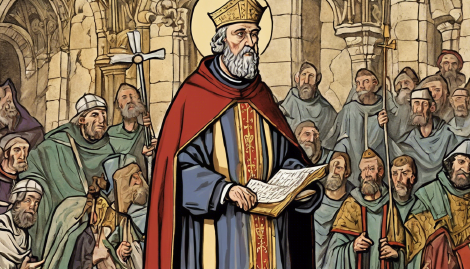
He was the first archbishop of Santiago, and a tireless promoter of the cult of St. James, the construction of the Romanesque cathedral, the development of the pilgrimage routes, and the political and cultural autonomy of Galicia.
He also played an important role in the Reconquista against the Muslims, and in the reform of the Church according to the Cluniac ideals.
Archbishop Gelmírez is buried in a Gothic tomb in the Chapel of Our Lady of Corticela, which is located inside the cathedral, on the right side of the main nave.
The tomb dates back to the 14th century, and has an effigy of the archbishop lying on top, wearing his episcopal vestments and holding his crozier and his mitre.
The tomb also has several reliefs depicting scenes from his life, such as his consecration as archbishop, his participation in the Battle of Uclés, his donation of lands to the cathedral, and his blessing of pilgrims.
The tomb of Archbishop Gelmírez is a tribute to his legacy as a spiritual leader, a builder, a warrior, a patron, and a reformer.
The Holy Remains of St. James
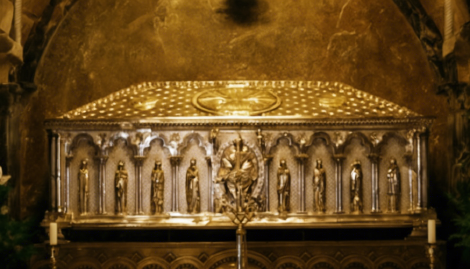
The beating heart of Catedral of Santiago de Compostela resides around the hallowed remains of St. James the Greater contained within.
According to medieval tradition, following St. James martyrdom his own followers transported the apostle’s severed relics by stone boat from Jaffa harbor to the remote northwestern Iberian coast during Herod Agrippa’s Palestine persecutions of early Christians.
Over 800 years later a local hermit unearthed an ancient triple marble sarcophagus with two disciples’ skeletons guarding the lead coffin identified locally as belonging to St. James himself.
Once authenticated in 813 AD by religious authorities, it became recognized as an authentic holy relic, spurring great veneration and the beginnings of the famed Santiago de Compostela pilgrimage.
Currently St. James’ remains are housed in an ornate late 19th century silver coffer, in the rear apse area of the Cathedral’s lower crypt levels.
Pilgrims finish their Camino trek before the Emerald Apostle statue marking the final steps to embrace the effigy and pass behind the altar to venerate the Flower-Crowned Silver Casket displayed containing one of Christ’s original apostles.
The discovery of such sacred remains embedded the city as a pillar of Christendom and the elaborate Cathedral housing them still thrives over 12 centuries later as the spiritual beacon for hundreds of thousands of devoted pilgrims traversing the Camino trails to pay final homage steps from St. James’ relics.
The Cathedral Bells
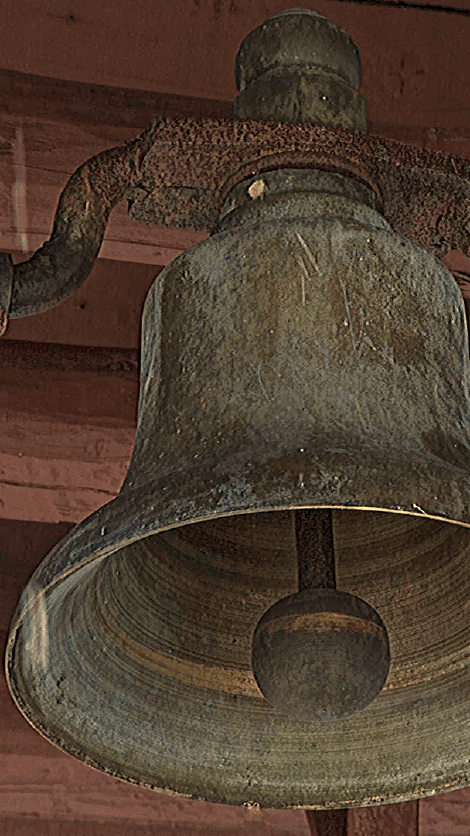
Many people ask “Does the Cathedral have bells?”. The answer is yes, and they have a fascinating history.
The bells of the cathedral are located in two towers: the Clock Tower and the Berenguela Tower. The Clock Tower has four bells, each with a name and a function: La Blanca (the White), which announces the canonical hours; La Meca (the Mecca), which calls for prayer; La Oscura (the Dark), which rings for funerals; and La Ronca (the Hoarse), which warns of storms .
The Berenguela Tower has one bell, also called La Berenguela, which is the largest and oldest bell in the cathedral. It weighs 7,000 kilograms and measures 2.2 meters in diameter .
The bells of the cathedral have witnessed many historical events and have endured many hardships. In 997, the Muslim army of Al-Mansur sacked the city and burned the cathedral, but spared the tomb of Saint James and the bells.
The bells were taken as spoils of war and carried to Cordoba, where they were used as lamps in the mosque. However, in 1077, King Alfonso VI of Castile reconquered Cordoba and recovered the bells, bringing them back to Santiago on the backs of Muslim prisoners.
In 1809, during the Napoleonic invasion, the French troops tried to melt the bells to make cannons, but they failed because of their high tin content . In 1921, a fire destroyed the wooden structure of the Berenguela Tower and caused the bell to fall and crack. It was replaced by a replica in 1971, while the original bell was moved to the cloister of the cathedral .
The bells of the cathedral are not only historical artifacts, but also symbols of faith and identity for the people of Santiago de Compostela. They ring every day to mark the time, to celebrate religious festivals, to honor saints and martyrs, to mourn the dead, and to welcome pilgrims.
They are also part of the cultural heritage of Galicia, as they inspire legends, songs, poems and stories. The bells of the cathedral are a living testimony of the history and spirituality of Santiago de Compostela.
Sculptures and Artworks
Among its many treasures, the cathedral’s sculptures offer a glimpse into the history, faith, and cultural expression that define this sacred space.
The Main Altar: Cornelis de Holanda’s Renaissance Vision
Inside the cathedral, visitors encounter the Main Altar, a dazzling display of Renaissance artistry crafted by the Dutch sculptor Cornelis de Holanda in the 16th century.
This magnificent altarpiece features a series of intricately carved reliefs depicting scenes from the life of Christ, including the Annunciation, the Nativity, and the Crucifixion.
Surrounding the central tableau are statues of the Twelve Apostles, each rendered with lifelike detail and expressive gestures.
From Saint Peter holding the keys to the kingdom of heaven to Saint John the Evangelist with his gospel book, these statues exemplify the idealized human form and spiritual fervor characteristic of Renaissance sculpture.
The Choir Stalls: Mateo de Prado’s Baroque Splendor
In the choir area of the cathedral, visitors encounter another artistic marvel: the elaborately carved Choir Stalls created by the Baroque sculptor Mateo de Prado in the 18th century.
Carved from richly ornamented walnut wood, these intricately detailed stalls feature a menagerie of fantastical creatures, grotesque masks, and symbolic motifs.
Amidst the ornamental flourishes, figures of saints, angels, and biblical scenes emerge, each meticulously carved with a sense of dynamism and depth.
From the imposing figure of Saint James the Moor-slayer to the serene visage of the Virgin Mary, these sculptures convey a sense of reverence and majesty befitting their sacred context.
The Holy Door: A Symbol of Spiritual Passage
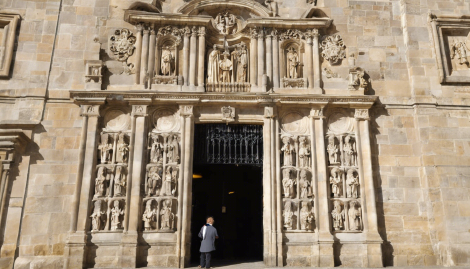
As pilgrims approach the Cathedral, they pass through the Holy Door, also known as The Door of Forgiveness, a portal located on the southern façade of the cathedral.
This intricately carved doorway features scenes from the life of Saint James and the miracles attributed to him, serving as a symbolic threshold between the earthly realm and the divine.
For centuries, pilgrims have passed through the Holy Door as they end their journey along the Camino de Santiago, seeking spiritual enlightenment and the blessing of Saint James.
Today, the door remains a potent symbol of pilgrimage and spiritual passage, inviting travelers to enter the cathedral as they complete their Camino.
The Botafumeiro: A Symbol of Pious Tradition
One of the most iconic artworks within the Cathedral is the Botafumeiro, a massive thurible or incense burner suspended from the ceiling of the transept.
This imposing silver vessel, measuring over six feet in height and weighing nearly 180 pounds, is swung through the air by a team of tiraboleiros during special ceremonies and liturgical celebrations.
The Botafumeiro has been in use since the Middle Ages, symbolizing purification and the lifting of prayers to the heavens.
Its mesmerizing swings fill the cathedral with clouds of fragrant incense, creating a sensory experience that captivates worshippers and visitors alike.
The Botafumeiro operates during the following Religious ceremonies
| Occasion | Date |
|---|---|
| The Epiphany | January 6 |
| Resurrection Sunday | - |
| The Apparition of the Apostle-Clavijo | May 23 |
| Pentecost | - |
| The Martyrdom of Saint James | July 25 |
| The Assumption of Mary | August 15 |
| All Saints | November 1 |
| Christ the King | - |
| The Immaculate Conception | December 8 |
| Christmas | December 25 |
| Transfer of the remains of the Apostle | December 30 |
The Codex Calixtinus: A Medieval Manuscript Marvel
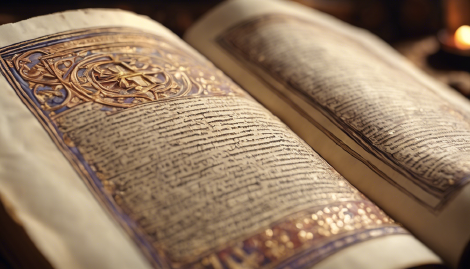
Housed within the cathedral’s archives is the Codex Calixtinus, a medieval manuscript dating back to the 12th century.
This illuminated manuscript, also known as the “Book of Saint James,” is a compendium of texts related to the pilgrimage to Santiago de Compostela, including sermons, liturgical chants, and accounts of miracles attributed to Saint James.
The Codex Calixtinus is celebrated not only for its historical and religious significance but also for its exquisite illumination and calligraphy. Its ornate pages feature intricate illustrations and decorative motifs that offer insight into the artistic techniques and religious devotion of the medieval period.
The Pórtico da Gloria: Maestro Mateo’s Magnificent Portal
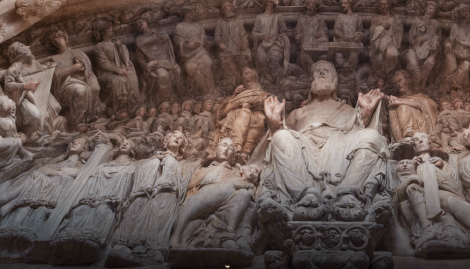
At the heart of the cathedral’s façade lies the Pórtico da Gloria, a magnificent sculptural ensemble crafted by the esteemed Maestro Mateo in the 12th century. While primarily known for its sculptural elements, the Pórtico da Gloria also features a series of vibrant frescoes adorning the arches and tympanum.
The Chapel of the Relics: A Treasury of Sacred Art
In the Chapel of the Relics, pilgrims encounter a dazzling array of paintings that pay homage to the saints and martyrs venerated within the cathedral.
Among these artworks is a series of votive paintings known as ex-votos, which were offered by pilgrims as tokens of gratitude for answered prayers and miraculous interventions.
One notable ex-voto painting depicts a pilgrim kneeling before the relics of Saint James, his hands clasped in prayer as he offers thanks for a miraculous healing.
Another painting portrays a shipwrecked sailor rescued from the stormy seas by the intercession of Saint James, his grateful expression a testament to the power of faith and divine intervention.
External Architecture
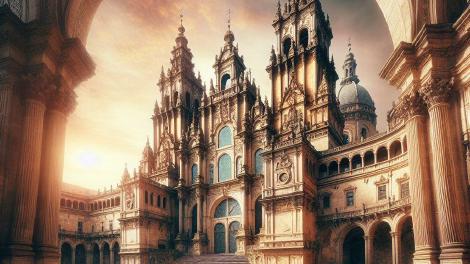
As pilgrims approach the Cathedral, they are met with a breathtaking display of architectural splendor and artistic treasures that have captivated visitors for centuries.
From its towering spires to its intricately carved façade, the external architecture of the cathedral stands as a testament to the enduring legacy of faith, pilgrimage, and artistic innovation.
A Monumental Façade
The western façade of the Cathedral is a masterpiece of Romanesque and Baroque architecture, stretching over 100 meters in length and rising to heights of over 30 meters.
Adorned with a wealth of sculptural details and decorative elements, the façade commands attention with its imposing presence and intricate craftsmanship.
Towering Spires and Graceful Buttresses
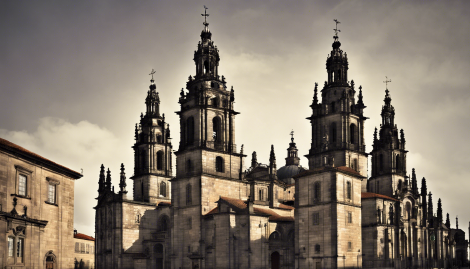
Dominating the skyline of Santiago de Compostela are the cathedral’s twin towers, rising to heights of over 75 meters above the surrounding cityscape. Constructed in the Gothic style, these towering spires serve as beacons of hope and inspiration for pilgrims making their way along the Camino.
Adorning the exterior walls of the cathedral are a series of flying buttresses, which provide structural support and stability to the towering edifice. These graceful stone arches, adorned with carved finials and intricate detailing, enhance the visual impact of the cathedral’s exterior while ensuring its structural integrity.
Magnificent Dimensions
The Cathedral of Santiago de Compostela boasts impressive dimensions that reflect its status as one of the largest and most important religious structures in Spain.
Measuring approximately 97 meters in length and 22 meters in width at its widest point, the cathedral’s interior height reaches up to 22 meters, creating a sense of spaciousness and grandeur within its sacred halls.
The cathedral’s main façade spans a width of over 22 meters and rises to a height of around 32 meters at its tallest point. Its proportions are meticulously designed to convey a sense of harmony and majesty, drawing pilgrims and visitors into a world of awe-inspiring beauty and spiritual significance.
The Surrounding Area of Santiago
Encircling the grand Cathedral is Campus Stellae, or the “Field of Stars” in Latin, the historic area whose hallowed medieval origin evolves from a celestial miracle.
As local legend recounts, in the 9th century a hermit followed an ethereal field of glittering stars outlining the forgotten tomb where the remains of St. James the Apostle laid hidden.
It is this once smoky star-scatter glowing mysteriously above the verdant Galician countryside that lends the location its Campus Stellae name.
Pilgrim’s Road & Final Steps
The Pilgrim’s Road & Final Steps is a significant part of the journey to the Catedral de Santiago de Compostela. This ancient stone roadway marks the final steps of the pilgrimage for many exhausted Camino walker.
This route passes the Puerta de Azabachería on the north side of the cathedral. From there, pilgrims go through a tunnel gate that leads them into the Obradoiro Square.
There is often a bagpiper in this tunnel, called the Arco de Palacio (Palace Arch), or some other Celtic group to serenade one’s entry into the square.
Looking through the Arco de Palacio, one catches their first glimpse of the Obradoiro Square. This is the square where the cathedral is most photographed with its western façade of the Obradoiro.
Plaza del Obradoiro
The expansive open square known as the Plaza del Obradoiro lies directly bordering the grand western entrance façade of the Cathedral, providing a spacious foreground to the ornate spires overlooking the plaza.
As the Obradoiro name suggests in Galician, this broad flat rectangular plaza served historically as a workshop area for stonemasons and artisans laboring over the Cathedral’s construction and upkeep.
Today the Plaza del Obradoiro acts as the ecstatic final destination for exhausted pilgrims completing the Camino de Santiago, their journey’s end marked by the sweeping Baroque vista of the cathedral’s Obradoiro façade.
Alameda Park
Just a short stroll west from the grand columns of the Obradoiro plaza unfolds the verdant, tree-lined respite of Alameda Park, whose name derives from the Spanish word for a tree-dotted walkway or promenade.
The park provides a lush pedestrian venue where strollers, sightseers, and pilgrims freshly arrived to Santiago can decompress amidst floral scents and whistling birdsong after weeks or months of arduous walking.
Quintana Square
Quintana Square, the heart of Santiago de Compostela, encapsulates a rich history dating back to its origins in 1611, when it transformed from a cemetery into a bustling public square.
The square is split into two distinct levels: the Quintana de Mortos (Quintana of the Dead) at the lower level, which served as a burial ground until 1780, and the Quintana de Vivos (Quintana of the Living) at the higher level.
Historic Streets
The narrow streets and squares of the old town are home to a variety of architectural styles, including Romanesque, Gothic, Renaissance, Baroque, and Neoclassicist buildings. This harmonious blend of styles makes Santiago de Compostela one of the world’s most beautiful urban areas.
Accommodation Options in Santiago
Santiago de Compostela offers a wide range of accommodation options to suit every budget and preference, ensuring a comfortable stay for visitors exploring this historic city. From luxurious hotels to cozy guesthouses and hostels, there’s something for everyone.
Luxury Accomodation
Santiago de Compostela is rich in history and culture, is a magnet for global visitors, leading to a high demand for luxury accommodation. As the endpoint of the renowned pilgrimage, many complete their spiritual journey by indulging in the comfort of upscale hotels.
These establishments often reside in historic buildings, offering a unique blend of luxury and history. The city’s rich cultural calendar further attracts a discerning clientele.
The high demand for such accommodations is met with superior service, including gourmet dining, spa services, and personalized care. However, the city also caters to budget-conscious travelers, ensuring a range of options for all visitors. Here are the top 5 luxury options in Santiago de Compostela:
- Eurostars Araguaney: known for its art gallery, outdoor swimming pool, gym, and sauna, offers spacious rooms and a prime location close to the city center.
- Parador de Santiago de Compostela: An architectural gem offering luxury and historical ambiance with views of the cathedral.
- Hotel Palacio del Carmen: A refined stay in a converted convent, blending historic charm with modern comforts.
- NH Collection Santiago de Compostela: Provides contemporary sophistication and proximity to the city’s main attractions.
- Hotel Entrecercas: Offers a charming stay in a traditional Galician house for budget-conscious travelers
| Hotel | Address | Description | Proximity to the Cathedral |
|---|---|---|---|
| Eurostars Araguaney | Alfredo Brañas, 5, Santiago de Compostela, 15701 | Known for its art gallery, outdoor swimming pool, gym, and sauna, offers spacious rooms and a prime location close to the city center. | 5-minute walk |
| Parador de Santiago de Compostela | Praza do Obradoiro, 1, Santiago de Compostela, 15705 | An architectural gem offering luxury and historical ambiance with views of the cathedral. | Located on Plaza de Obradoiro, next to the Cathedral |
| Hotel Palacio del Carmen | Oblatas, s/n, Santiago de Compostela, 15703 | A refined stay in a converted convent, blending historic charm with modern comforts. | Approximately 1 km |
| NH Collection Santiago de Compostela | Avenida Burgo de las Naciones s/n, 15705 Santiago de Compostela | Provides contemporary sophistication and proximity to the city’s main attractions. | 13-minute walk |
| Hotel Entrecercas | Entrecercas, 11, Santiago de Compostela, 15704 | Offers a charming stay in a traditional Galician house for budget-conscious travelers. | 5-minute walk |
Please note that the price range information was not available at the time of the search. For the most accurate and up-to-date information, I recommend checking the hotels’ official websites or contacting them directly.
Albergues for Pilgrims
For pilgrims and budget travelers, Santiago de Compostela has a robust network of albergues (hostels) and guesthouses (pensiones), providing a more affordable and communal lodging experience.
Albergues offer a unique, community-focused atmosphere with shared facilities, often including cooking areas or communal meals, and are a great way to meet fellow travelers.
These accommodations can vary significantly, so it’s beneficial to research or speak with someone knowledgeable about the specific hostel’s amenities and atmosphere. To help you choose, here are the top five Albergues in Santiago:
Albergue Seminario Menor
- Address: Avenida Quiroga Palacios, 2 A, Santiago de Compostela, 15703
- Proximity to the Cathedral: 10-minute walk
- Rating: 3.5/5 based on 252 reviews
Albergue Fin del Camino
- Address: Rúa de Moscova, 15707 Santiago de Compostela (Galicia)
- Phone Number: 981 58 73 24
- Proximity to the Cathedral: Approximately 2.5 km
- Rating: 4.1/5 based on 117 reviews
Pilgrim House Santiago
- Address: C/ Nova, 19 - BAJO, 15705 Santiago DE Compostela (A Coruña)
- Phone Number: 981 58 57 88
- Open Hours: Monday to Tuesday 09:00 - 16:00, Thursday to Saturday 10:00 - 16:00
- Proximity to the Cathedral: A couple of blocks behind the Cathedral
- Rating: 5.0/5 based on 7 reviews
Camino De Santiago Forum
- Address: Travesa Da Universidade, 1, 15704 Santiago De Compostela (A Coruña)
- Phone Number: 667 29 04 65
- Open Hours: Monday to Friday 10:00 - 14:00
- Proximity to the Cathedral: approximately 1.2 km
- Rating: 4.6/5 based on 566 reviews
Parador de Santiago - Hostal Reis Catolicos
- Address: Praza do Obradoiro, 1, Santiago de Compostela, 15705
- Phone Number: 981 58 22 00
- Proximity to the Cathedral: Located on Plaza de Obradoiro, next to the Cathedral
- Rating: 4.5/5 based on 3044 reviews
Please note that it’s always a good idea to check the latest reviews and availability before planning your stay.
Rural Guest Houses
Country houses (Casas Rurales) offer a charming and immersive countryside experience, set in rural areas to connect guests with the region’s natural beauty in a comfortable and rustic setting.
For those looking for an extraordinary stay, Paradors provide luxurious accommodations in historic buildings, such as castles or monasteries, blending comfort with history for a unique lodging experience.
Regardless of where you choose to stay, it’s advisable to book in advance, especially during peak pilgrimage seasons, to secure your preferred accommodation.
For more detailed information and to plan your visit, it’s recommended to check the official websites and Spain’s tourism board

